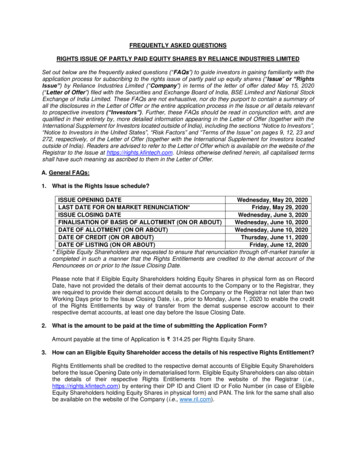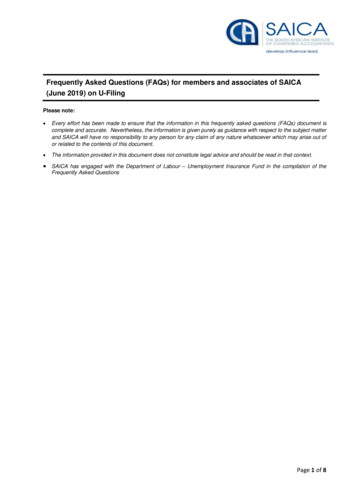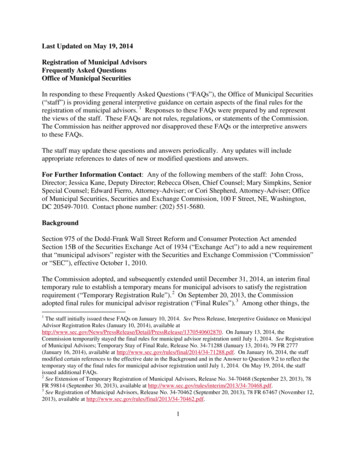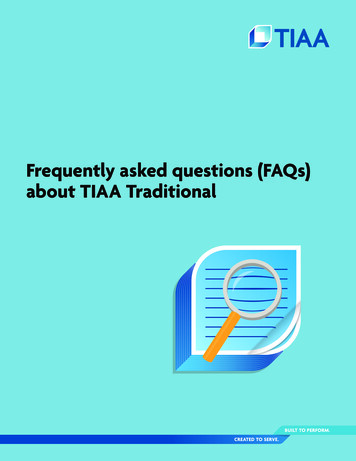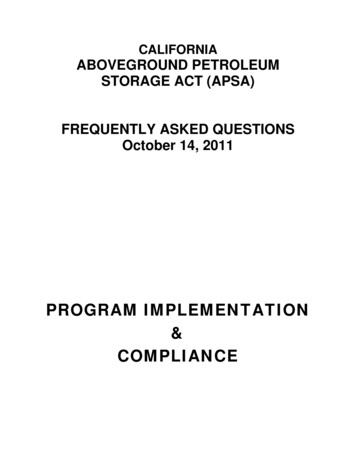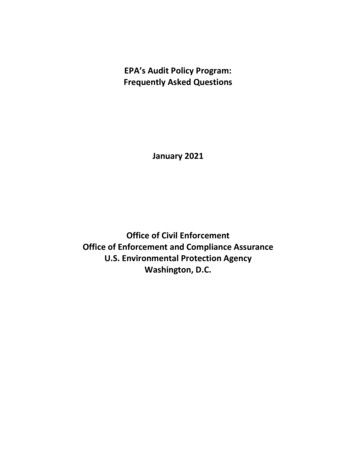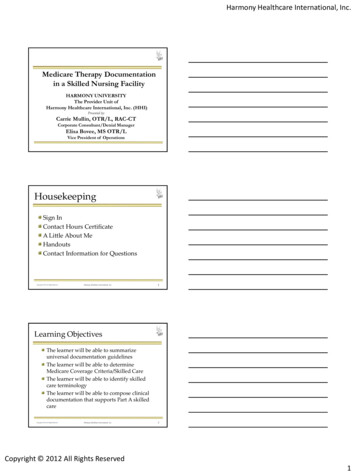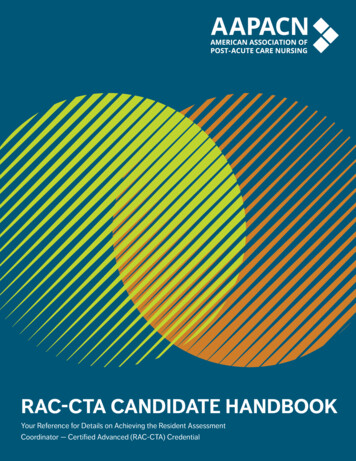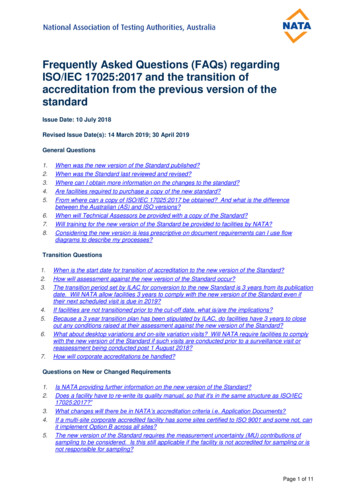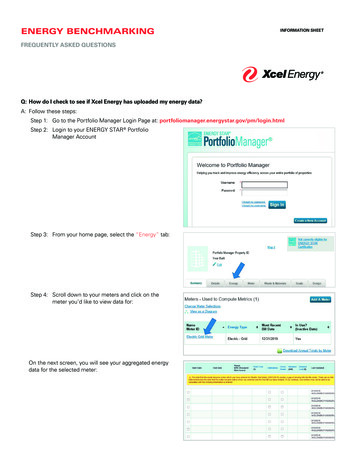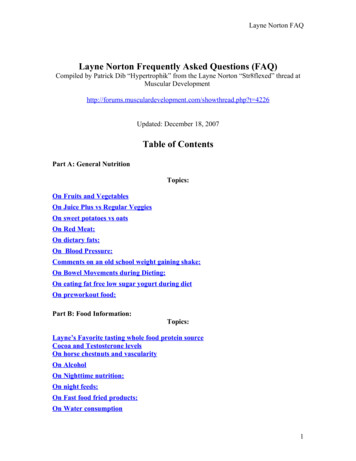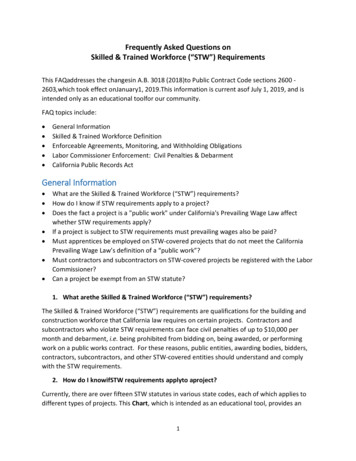
Transcription
Frequently Asked Questions onSkilled & Trained Workforce (“STW”) RequirementsThis FAQ addresses the changes in A.B. 3018 (2018) to Public Contract Code sections 2600 2603, which took effect on January 1, 2019. This information is current as of July 1, 2019, and isintended only as an educational tool for our community.FAQ topics include: General InformationSkilled & Trained Workforce DefinitionEnforceable Agreements, Monitoring, and Withholding ObligationsLabor Commissioner Enforcement: Civil Penalties & DebarmentCalifornia Public Records ActGeneral Information What are the Skilled & Trained Workforce (“STW”) requirements?How do I know if STW requirements apply to a project?Does the fact a project is a "public work" under California's Prevailing Wage Law affectwhether STW requirements apply?If a project is subject to STW requirements must prevailing wages also be paid?Must apprentices be employed on STW-covered projects that do not meet the CaliforniaPrevailing Wage Law’s definition of a “public work”?Must contractors and subcontractors on STW-covered projects be registered with the LaborCommissioner?Can a project be exempt from an STW statute?1. What are the Skilled & Trained Workforce (“STW”) requirements?The Skilled & Trained Workforce (“STW”) requirements are qualifications for the building andconstruction workforce that California law requires on certain projects. Contractors andsubcontractors who violate STW requirements can face civil penalties of up to 10,000 permonth and debarment, i.e. being prohibited from bidding on, being awarded, or performingwork on a public works contract. For these reasons, public entities, awarding bodies, bidders,contractors, subcontractors, and other STW-covered entities should understand and complywith the STW requirements.2. How do I know if STW requirements apply to a project?Currently, there are over fifteen STW statutes in various state codes, each of which applies todifferent types of projects. This Chart, which is intended as an educational tool, provides an1
overview of the current STW statutes as of July 1, 2019, and the types of projects to which theyapply.In addition, the Public Contract Code authorizes public entities and awarding bodies to requirebidders, contractors, or other entities to use a Skilled & Trained Workforce even in the absenceof an STW statute or regulation mandating its use.3. Does the fact a project is a “public work” under the California Prevailing Wage Lawaffect whether STW requirements apply?No. The fact a project is a “public work” or “private work” under the California Prevailing WageLaw (California Labor Code sections 1720 - 1815) has no bearing on whether STW requirementsapply, and vice versa. A project could be subject to either STW or California Prevailing WageLaw requirements, both, or neither.4. If a project is subject to STW requirements, must prevailing wages also be paid?Not necessarily. There is no general requirement that prevailing wages must be paid on allSTW-covered projects. However, some STW statutes contain their own requirement separatefrom the California Prevailing Wage Law that prevailing wage rates must be paid on the STWcovered project. These statutes are summarized, for educational purposes, on this Chart.5. Must apprentices be employed on STW-covered projects that do not meet theCalifornia Prevailing Wage Law’s definition of a “public work”?No. In contrast to “public works” projects under the California Prevailing Wage Law, there is norequirement that apprentices must be employed on an STW-covered project (assuming theproject is not a public work). However, the STW apprentices in DAS-approved apprenticeshipprograms do count towards the STW requirements.6. Must contractors and subcontractors on STW-covered projects be registered with theLabor Commissioner?No. In contrast to “public works” projects under the California Prevailing Wage Law, there is norequirement that contractors and subcontractors on STW-covered projects be registered withthe Labor Commissioner. However, if the STW-covered project is a “public work,” then theCalifornia Prevailing Wage Law’s contractor and subcontractor registration requirements apply.7. Can a project be exempt from an STW statute?Each STW statute or STW requirement imposed by a public entity or awarding body must beindividually reviewed to determine if there are any exemptions. As summarized in this Chartfor educational purposes, many (but not all) of the STW statutes contain limited exemptions forprojects subject to project labor agreements which meet certain statutory requirements.2
Skilled & Trained Workforce Definition What is the definition of a Skilled & Trained Workforce?What is the definition of a Skilled & Trained Workforce under Chapter 2.9 of Part 1 ofDivision 2 of the Public Contract Code (sections 2600 - 2603)?How do you calculate the Minimum Percentage Graduation Requirements under PublicContract Code sections 2600 - 2603?Under Public Contract Code sections 2600 - 2603, do the Minimum Percentage GraduationRequirements apply to occupations in which the DAS approved no apprenticeship programbefore January 1, 1995?Under Public Contract Code sections 2600 – 2603, are there any exemptions from theMinimum Percentage Graduation Requirements for a contractor or subcontractor formonths in which the contractor or subcontractor performs fewer than 10 hours ofwork on the project?Under Public Contract Code sections 2600 - 2603, are there any exemptions from theMinimum Percentage Graduation Requirements for subcontractors whose subcontracts areless than one-half of one-percent of the prime contract?What are some tools to help verify if an individual has graduated from an apprenticeshipprogram?If an apprenticeable occupation is completely or partially exempt from the MinimumPercentage Graduation Requirements, is the contractor or subcontractor still otherwiserequired to comply with the remaining Skilled & Trained Workforce requirements underPublic Contract Code sections 2600 – 2603?1. What is the definition of a Skilled & Trained Workforce?There is no single definition of a Skilled & Trained Workforce that applies to all projects.Instead, each STW statute contains its own definition. This Chart, which is intended foreducational purposes, summarizes the various STW definitions.The vast majority (but not all) of the STW statutes use the Skilled & Trained Workforcedefinition in Public Contract Code Section 2601. This definition applies whenever a statute orregulation requires a public entity to obtain a legally enforceable commitment that a bidder,contractor, or other entity (like a private developer, for example) will use a Skilled & TrainedWorkforce to complete a contract or project.2. What is the definition of a Skilled & Trained Workforce under Chapter 2.9 of Part 1 ofDivision 2 of the Public Contract Code (sections 2600 - 2603)?Section 2601 of the Public Contract Code defines a Skilled & Trained Workforce as onethat meets both of the following:a. Requirement #1: All the workers performing work in an apprenticeable occupation in3
the building and construction trades for which the Division of ApprenticeshipStandards (“DAS”) approved an apprenticeship program before January 1, 2014 areeither:a. Apprentices registered in a DAS-approved apprenticeship program;ORb. “Skilled journeypersons,” meaning the worker, in the applicable occupation,either (i) graduated from an in-state, DAS-approved apprenticeship program,or an out-of-state federally-approved apprenticeship program, or (ii) has atleast as many hours of on-the-job experience as would be required tograduate from the applicable DAS-approved apprenticeship program.ANDb. Requirement #2: The Minimum Percentage Graduation Requirements in Table 1 aresatisfied.a. “Minimum Percentage Graduation Requirements” means the minimumpercentage of skilled journeypersons who (i) are employed to performwork on the contract or project, (ii) by every contractor and each of itssubcontractors at every tier, (iii) for the applicable occupation, and (iv) aregraduates of either an in-state, DAS-approved apprenticeship program orof an out-of-state federally-approved apprenticeship program. Individualswho qualify as “skilled journeypersons” based on their on-the-jobexperience do not count towards the Minimum Percentage GraduationRequirements.TABLE 1: MINIMUM PERCENTAGE GRADUATION REQUIREMENTSDate Work Performedon Contract or ProjectOn or after January 1,2017On or after January 1,2018On or after January mum Percentage GraduationRequirement Does Not Apply to theFollowing Occupations (Alphabetical):40Acoustical installer, bricklayer,carpenter, cement mason, drywallinstaller or lather, marble mason,finisher, or setter, modular furniture orsystems installer, operating engineer,pile driver, plasterer, roofer orwaterproofer, stone mason, surveyor,teamster, terrazzo worker or finisher,and tile layer, setter, or finisherAcoustical installer, bricklayer,carpenter, cement mason, drywallTeamster504
Date Work Performedon Contract or ProjectOn or after January m Percentage GraduationRequirement Does Not Apply to theFollowing Occupations (Alphabetical):installer or lather, marble mason,finisher, or setter, modular furniture orsystems installer, operating engineer,pile driver, plasterer, roofer orwaterproofer, stone mason, surveyor,teamster, terrazzo worker or finisher,and tile layer, setter, or finisherAcoustical installer, bricklayer,carpenter, cement mason, drywallinstaller or lather, marble mason,finisher, or setter, modular furniture orsystems installer, operating engineer,pile driver, plasterer, roofer orwaterproofer, stone mason, surveyor,teamster, terrazzo worker or finisher,and tile layer, setter, or finisher60As shown in Table 1, the Minimum Graduation requirements do not apply to teamsters.The Minimum Graduation Requirements are fixed at 30% for: acoustical installers,bricklayers, carpenters, cement masons, drywall installers or lathers, marble masons,finishers, or setters, modular furniture or systems installers, operating engineers, piledrivers, plasterers, roofers or waterproofers, stone masons, surveyors, terrazzo workersor finishers, and tile layers, setters, and finishers. For all other apprenticeableoccupations, the Minimum Graduation Percentage Requirements increase by 10%annually, from 30% on January 1, 2017, to 60% on January 1, 2020.3. How do you calculate the Minimum Percentage Graduation Requirements underPublic Contract Code sections 2600 - 2603?Three general rules apply. First, the Minimum Percentage Graduation Requirements arecalculated by each individual contractor and subcontractor, and within each contractor andsubcontractor, by each apprenticeable occupation.Example:Contractor A is the prime contractor on a project which began on July 2, 2018. Subcontractor Bemploys ten tile layers, all of whom meet the Minimum Graduation Requirements, and twoglaziers, none of whom meet the Minimum Graduation requirements. Subcontractor C employstwo tile layers, none of whom meet the Minimum Graduation Requirements, and fifteenglaziers, all of whom meet the Minimum Graduation Requirements.Analysis:5
Subcontractors B and C are not compliant with the Minimum Graduation Requirements.Workforces may not be “combined” across subcontractors. Subcontractor B violates theMinimum Graduation Requirements for glaziers. Subcontractor C violates the MinimumGraduation Requirements for tile layers. Subcontractors B and C are liable for penalties of up to 5,000 for each calendar month during which they failed to meet the STW requirements[ 10,000 if it was a second or subsequent violation within a three-year period]. Contractor A isliable for the penalties as a result of subcontractors B and C’s failure to comply with the STWrequirements, unless the conditions specified in Public Contract Code section 2603(f) have beenmet.Second, the Minimum Percentage Graduation Requirements must be calculated on a monthlybasis for the calendar month covered by the Monthly Compliance Report that the contractor,bidder, or other entity must submit to the public entity or other awarding body.Third, the Minimum Percentage Graduation Requirements must be calculated for the applicablecontractor or subcontractor during the relevant calendar month by either (a) the percentage ofskilled journeypersons who meet the graduation requirements in Table 1, or (b) the number ofhours of work performed by skilled journeypersons who meet the graduation requirements.Example:During the calendar month covered by its Monthly Compliance Report (January 7 to February 7,2019), Subcontractor D employs four glaziers. One glazier graduated from a DAS-approvedapprenticeship program. The remaining three glaziers have equivalent hours of on-the-jobexperience. The one glazier who graduated from a DAS-approved apprenticeship programworked 45 hours on the project that month. The remaining three glaziers with equivalent onthe-job experience each worked 15 hours.Analysis:Subcontractor D is in compliance with the Minimum Graduation Requirements. Even thoughonly one of the four glaziers graduated from a DAS-approved apprenticeship program (25% islower than the 50% Minimum Percentage Graduation Requirement for glaziers as of January 1,2019), the one glazier worked 45 out of the 90 monthly hours performed by Subcontractor D’sglaziers on the project. Because these 45 hours are at least 50% of Subcontractor D’s total 90glazier hours for the calendar month, the Minimum Graduation Requirements are satisfied.4. Under Public Contract Code sections 2600 - 2603, do the Minimum PercentageGraduation Requirements apply to occupations in which the DAS approved noapprenticeship program before January 1, 1995?There is a partial exemption. For apprenticeable occupations for which the DAS had approvedno apprenticeship program before January 1, 1995, up to one one-half of the MinimumPercentage Graduation Requirements in Table 1 may be satisfied by skilled journeypersonswho began working in the apprenticeable occupation before the DAS approved anapprenticeship program for that occupation in the county in which the project is located.6
5. Under Public Contract Code sections 2600 - 2603, are there any exemptions from theMinimum Percentage Graduation Requirements for a contractor or subcontractor formonths in which the contractor or subcontractor performs fewer than 10 hours ofwork on the project?Yes, under certain circumstances. A contractor or subcontractor is exempt from the MinimumPercentage Graduation Requirements if, during the calendar month covered by the MonthlyCompliance Report, the contractor or subcontractor employs skilled journeypersons who, intotal, perform fewer than 10 hours of work in a particular craft on the contract or project. Allother STW requirements still apply to the contractor or subcontractor.Example:Subcontractor A employs 9 carpenters, each of whom, during the relevant calendar month,works 1 hour on the project. Subcontractor A also employs 4 roofers, each of whom, during therelevant calendar month, works 3 hours on the project, and one cement mason, who, during therelevant calendar month, works 10 hours on the project.Analysis:Subcontractor A’s carpenters are exempt from the Minimum Percentage GraduationRequirement for the calendar month. Subcontractor A’s carpenters worked only 9 hours.Subcontractor A’s roofers and cement mason are not exempt from the Minimum PercentageGraduation Requirements. They worked 12 and 10 hours respectively, which is in excess of thefewer than 10-hour threshold.6. Are there any exemptions under Public Contract Code sections 2600-2603 from theMinimum Percentage Graduation Requirements for subcontractors whosesubcontracts are less than one-half of one-percent of the prime contract?Yes, under certain circumstances. A subcontractor is exempt from meeting the MinimumGraduation Requirements if it meets both of the following: (i) the subcontractor was nota listed subcontractor under Public Contract Code section 4104 or a substitute for a listedsubcontractor, and (ii) the subcontract does not exceed one-half of one percent of theprice of the prime contract. All other STW requirements still apply to the subcontractor.7. What are some tools to help verify if an individual has graduated from anapprenticeship program?Apprentices To verify if an individual is currently registered in a DAS-approved apprenticeship program,click here.Skilled Journeypersons To verify if an individual has graduated from an in-state, DAS-approved7
apprenticeship program, click here.To verify if an individual has graduated from an out-of-state, federally-approvedapprenticeship program, please contact the federally approved ApprenticeshipAgency for that state. Click here for contact information.8. If an apprenticeable occupation is completely or partially exempt from theMinimum Percentage Graduation Requirements, is the contractor orsubcontractor still otherwise required to comply with the remaining Skilled &Trained Workforce requirements under Public Contract Code sections 2600 –2603?Yes. If an apprenticeable occupation is completely or partially exempt from theMinimum Percentage Graduation Requirements, the contractor or subcontractor muststill comply with all of the remaining Skilled & Trained Workforce requirements underPublic Contract Code sections 2600 – 2603.Examples of these remaining STW requirements include, but are not limited to: The requirement that all workers performing work in an apprenticeable occupation inthe building and construction trades for which the DAS approved an apprenticeshipprogram before January 1, 2014, are either (1) apprentices registered in a DASapproved apprenticeship program, or (2) skilled journeypersons as defined above; Completion of Monthly Compliance Reports; Submission and/or compliance with a Substantial Compliance Plan, if applicable, etc.Enforceable Agreements, Monitoring, and Withholding ObligationsDefinitions What is an Enforceable Agreement under Public Contract Code sections 2600 – 2603?What is a Monthly Compliance Report under Public Contract Code sections 2600 –2603?What is a Substantial Compliance Plan under Public Contract Code sections 2600 –2603?Monitoring & Withholding Obligations – Public Entities and Awarding Bodies What are the monitoring and withholding obligations of public entities and awardingbodies with respect to the STW requirements under Public Contract Code sections 2600- 2603?What are the obligations of the public entity or other awarding body if the contractor,bidder, or other entity submits a Monthly Compliance Report that does notdemonstrate compliance with the requirements of Public Contract Code sections 2600 –2603?8
If a public entity or awarding body withholds funds because a contractor, bidder, orother entity submitted a Monthly Compliance Report that does not demonstratecompliance with the STW requirements under Public Contract Code sections 2600 –2603, under what circumstances must the public entity resume payment of those funds?What are the withholding obligations of the public entity or other awarding body if thecontractor, bidder, or other entity fails to provide a Monthly Compliance Report orprovides an incomplete Monthly Compliance Report?Monitoring & Withholding Obligations – Contractors, Bidders, and Other Entities What are the monitoring and withholding obligations of contractors, bidders, and otherentities with respect to the STW requirements under Public Contract Code sections 2600- 2603?If a subcontractor does not comply with the STW requirements under Public ContractCode sections 2600 – 2603, what actions may the contractor, bidder, or other entitytake against the offending subcontractor?Monitoring & Withholding Obligations – Subcontractors What are the obligations of subcontractors under Public Contract Code sections 2600 2603?Definitions1. What is an Enforceable Agreement under Public Contract Code sections 2600 - 2603?Whenever a contractor, bidder, or other entity is required to provide an enforceablecommitment that a Skilled & Trained Workforce will be used to complete a contract or project,the public entity or other awarding body and the bidder, contractor, or other entity must enterinto an enforceable written agreement that contains both of the following terms: The contractor, bidder, or other entity, and its contractors and subcontractors at every tier,will comply with Chapter 2.9 of Part 1 of Division 2 of the Public Contract Code (sections2600 - 2603 ); andThe contractor, bidder, or other entity will provide to the public entity or other awardingbody, on a monthly basis while the project or contract is being performed, a MonthlyCompliance Report.2. What is a Monthly Compliance Report under Public Contract Code sections 2600 2603?The Monthly Compliance Report must contain information demonstrating that the contractorand its subcontractors at every tier have complied with all of the requirements of Chapter 2.9of Part 1 of Division 2 of the Public Contract Code (sections 2600 - 2603). The statute does not9
specify the form of the Monthly Compliance Report, only that the report must containinformation sufficient to demonstrate that the STW requirements have been met.The contractor, bidder, or other entity must submit a Monthly Compliance Report to the publicentity on a monthly basis for each month while the STW-covered project or contract is beingperformed. The report covers a calendar month. If work on the STW-covered project began onSeptember 7, 2019, the first Monthly Compliance Report would be from September 7 toOctober 7, 2019.3. What is a Substantial Compliance Plan under Public Contract Code sections 2600 2603?If a contractor submits a Monthly Compliance Report to a public entity or awarding body thatfails to demonstrate compliance with the requirements of Public Contract Code sections 2600 2603, then the public entity must withhold funds from the contractor. For the public entity toresume payments under these circumstances, the contractor must submit a SubstantialCompliance Plan. The statute does not specify the exact form of the plan, only that it must be aplan to achieve “substantial compliance” with Public Contract Code sections 2600 – 2603 withrespect to the apprenticeable occupation(s) for which the STW requirements were violatedbefore the contract or project is completed.A public entity may reject a Substantial Compliance Plan as insufficient and refuse to resumepayments to the contractor only if within a reasonable time, the public entity notifies thecontractor of the reasons of the rejection.Monitoring & Withholding Obligations – Public Entities and Awarding Bodies4. What are the monitoring and withholding obligations of public entities and awardingbodies with respect to the STW requirements under Public Contract Code sections2600 - 2603?Generally, the obligations of public entities and awarding bodies are: (1) to make anEnforceable Agreement with the contractor, bidder, or other entity on the project regardingthe use of a Skilled & Trained Workforce, (2) to collect and review Monthly ComplianceReports from the contractor, bidder, or other entity to ensure that it demonstrates compliancewith the STW requirements; (3) if the Monthly Compliance Report is not provided, incomplete,or does not demonstrate compliance with Public Contract Code sections 2600 - 2603, towithhold payments; and (4) under certain circumstances, to forward Monthly ComplianceReports and Substantial Compliance Plans to the Labor Commissioner.5. What are the obligations of the public entity or other awarding body if the contractor,bidder, or other entity submits a Monthly Compliance Report that does notdemonstrate compliance with the requirements of Public Contract Code sections 2600– 2603?10
The public entity or other awarding body must do all of the following: Withhold further payments in an amount equal to (1) 150 percent of the value of themonthly billing for the contractor, bidder, or entity that failed to comply with the STWrequirements of Public Contract Code sections 2600 – 2603, or (2) 150 percent of thevalue of the monthly billing for the subcontractor that failed to comply with the STWrequirements of Public Contract Code sections 2600 – 2603.Forward a copy of the Monthly Compliance Report to the Labor Commissioner for theissuance of a Civil Wage and Penalty Assessment under Public Contract Code section2603; andForward a copy of the Substantial Compliance Plan, if any, submitted by the contractor,bidder, or other entity, and the response to that plan, if any, by the public agency orawarding body.6. If a public entity or awarding body withholds funds because a contractor, bidder, orother entity submitted a Monthly Compliance Report that does not demonstratecompliance with the STW requirements under Public Contract Code sections 2600 –2603, under what circumstances must the public entity resume payment of thosefunds?The public entity must immediately resume making payments to the contractor, bidder, orother entity, including all previously withheld payments, if either of the following occur: Substitution of Offending Subcontractor: (1) The contractor, bidder, or other entitysubstitutes the offending subcontractor who violated the STW requirements of PublicContract Code sections 2600 – 2603 for failure to demonstrate compliance, inaccordance with Public Contract Code sections 4100 – 4114, and (2) the contractor,bidder, or other entity replaces the offending subcontractor with one that provides anenforceable commitment that a skilled and trained workforce will be used to completethe contract or project.OR Submission of a Substantial Compliance Plan: If the contractor, bidder, or other entitysubmits to the public entity or awarding body a Substantial Compliance Plan, unlesswithin a reasonable time, the public agency or awarding body rejects the plan asinsufficient and explains the reason for the rejection.7. What are the withholding obligations of the public entity or other awarding body ifthe contractor, bidder, or other entity fails to provide a Monthly Compliance Report orprovides an incomplete Monthly Compliance Report?11
If the contractor fails to provide a Monthly Compliance Report or provides an incompleteMonthly Compliance Report, the public entity or other awarding body must withhold all furtherpayments. However, if the monthly report is incomplete because a subcontractor failed totimely submit the required information to the contractor, the public entity or other awardingbody must withhold an amount only equal to 150 percent (150%) of the value of the monthlybilling for the relevant subcontractor. NOTE: The contractor may withhold the same amount from the subcontractor until thesubcontractor provides a complete report and the awarding body subsequently pays thewithheld amounts to the contractor.The public entity must immediately resume making payments to the contractor, bidder, orother entity, including all previously withheld payments, if either of the following occur: A complete report is provided. Substitution of Offending Subcontractor: (1) The contractor, bidder, or other entitysubstitutes the offending subcontractor who violated the STW requirements of PublicContract Code sections 2600 – 2603 for failure to demonstrate compliance, inaccordance with Public Contract Code sections 4100 – 4114, and (2) the contractor,bidder, or other entity replaces the offending subcontractor with one that provides anenforceable commitment that a skilled and trained workforce will be used to completethe contract or project.ORMonitoring & Withholding Obligations – Contractors, Bidders, and Other Entities8. What are the monitoring and withholding obligations of contractors, bidders, andother entities with respect to the STW requirements under Public Contract Codesections 2600 - 2603?Generally, the obligations of contractors, bidders, and other entities are: (1) to enter into anEnforceable Agreement with the public entity or awarding body that the contractor, bidder, orother entity and its contractors and subcontractors at every tier, will comply with the STWrequirements of Public Contract Code section 2600 - 2603, (2) to provide to the public entity orother awarding body on a monthly basis while the project or contract is being performed, aMonthly Compliance Report demonstrating compliance with the STW requirements, and (3) ifnecessary, to submit and comply with a Substantial Compliance Plan.Also, contactors are financially liable for civil penalties assessed against their subcontractors asa result of a subcontractor’s failure to comply with the STW requirements. Contractors mayavoid these substantial liabilities by doing all of the following:12
Include a copy of Chapter 2.9 of Part 1 of Division 2 of the Public Contract Code (sections2600 - 2603) in contracts executed after January 1, 2019, between the contractor and thesubcontractor for work on the STW-covered project;Periodically monitor the subcontractor’s use of a Skilled & Trained Workforce;Take corrective action, upon becoming aware of the subcontractor’s violation, including, butnot limited to retaining 150 percent of the amount due to the subcontractor for workperformed on the project until the failure is corrected; andObtain a declaration signed under penalty of perjury from the subcontractor that thesubcontractor has met the requirements of Public Contract Code sections 2600 - 2603 priorto making the final payment to the subcontractor for its work on the project.Because the consequences of violations on STW-covered projects can include substantial civilpenalties and debarment, contractors may want to consider engaging in the above-listedactions as standard operating procedure.9. If a subcontractor does not comply with
No. In contrast to "public works" projects under the California Prevailing Wage Law, there is no requirement that contractors and subcontractors on -covered projects be registered with the . However, if the STW-covered project a "public work," California Prevailing Wage Law's contractor and subcontractor registration requirements apply.
